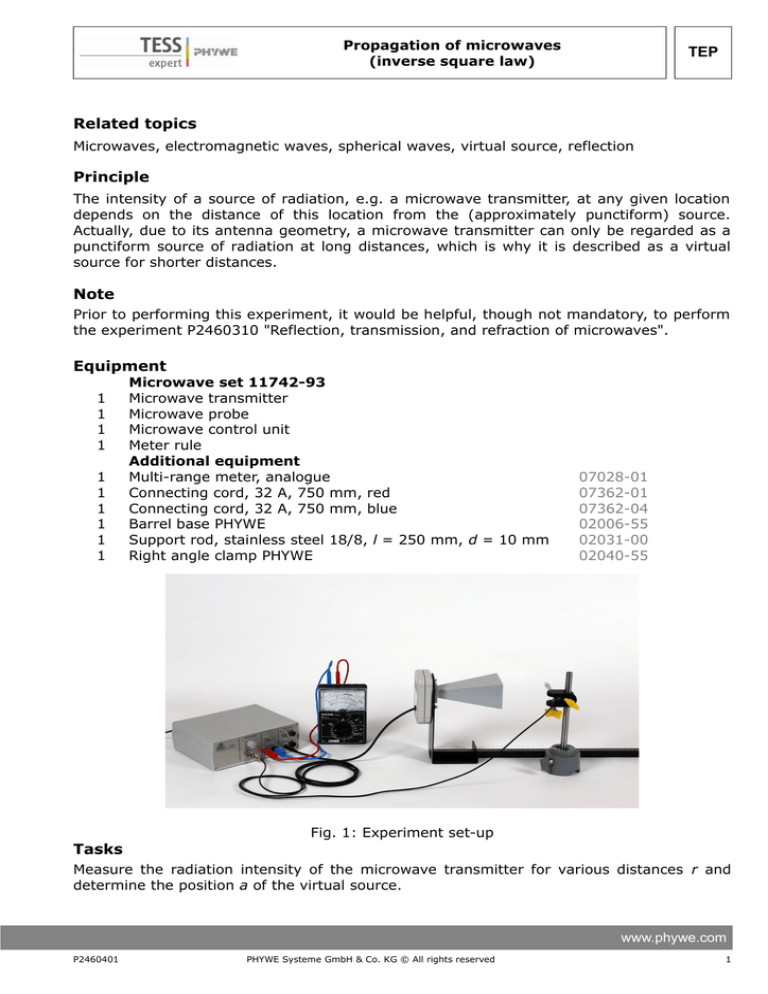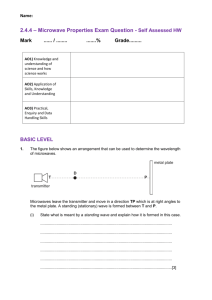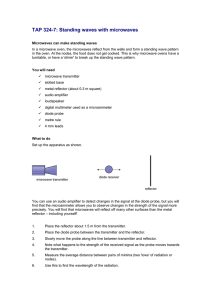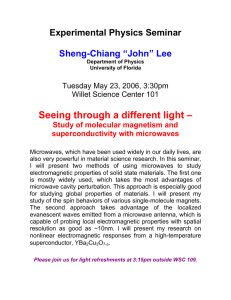Propagation of microwaves (inverse square law)
advertisement

Propagation of microwaves (inverse square law) TEP Related topics Microwaves, electromagnetic waves, spherical waves, virtual source, reflection Principle The intensity of a source of radiation, e.g. a microwave transmitter, at any given location depends on the distance of this location from the (approximately punctiform) source. Actually, due to its antenna geometry, a microwave transmitter can only be regarded as a punctiform source of radiation at long distances, which is why it is described as a virtual source for shorter distances. Note Prior to performing this experiment, it would be helpful, though not mandatory, to perform the experiment P2460310 "Reflection, transmission, and refraction of microwaves". Equipment 1 1 1 1 1 1 1 1 1 1 Tasks Microwave set 11742-93 Microwave transmitter Microwave probe Microwave control unit Meter rule Additional equipment Multi-range meter, analogue Connecting cord, 32 A, 750 mm, red Connecting cord, 32 A, 750 mm, blue Barrel base PHYWE Support rod, stainless steel 18/8, l = 250 mm, d = 10 mm Right angle clamp PHYWE 07028-01 07362-01 07362-04 02006-55 02031-00 02040-55 Fig. 1: Experiment set-up Measure the radiation intensity of the microwave transmitter for various distances r and determine the position a of the virtual source. www.phywe.com P2460401 PHYWE Systeme GmbH & Co. KG © All rights reserved 1 TEP Propagation of microwaves (inverse square law) Theory The waves that are emitted by microwave transmitters are spherical waves whose wave fronts can be described as the surfaces of spheres. During the propagation of these wave fronts, the law of conservation of energy applies: When one of the shells propagates, the next higher shell includes the same (total) energy with a lower energy density. Based on the spherical geometry (radius r, surface of sphere O = 4πr2) the decrease in intensity I results as follows: I (r )∼ 1 r2 (1) This is the inverse square law. It applies to all spherical waves. Since the intensity is the square of the amplitude of the electric field strength E, it decreases as a function of the inverse distance: E (r )∼ 1 r (2) However, this is only approximately true for the present experiment, since the funnelshaped geometry of the source affects the propagation of the waves in the case of short distances (reflection inside the funnel). This is why it is useful to calculate with an effective geometry, which assumes the existence of a virtual source at the distance a from the transmitter (see Fig. 2). Fig. 2: Transmitter and virtual source Accordingly, the length r must be corrected based on the position of the virtual source when measuring the intensity. In the case of the present set-up, the intensity is measured by way of a probe that emits a voltage signal U that is proportional to the intensity: 1 2 (r −a) (3) 1 ∼r −a √U (4) U∼ As a result, the following applies: This relationship enables not only the verification of the inverse square law, but also the determination of the location of the virtual source. 2 PHYWE Systeme GmbH & Co. KG © All rights reserved P2460401 Propagation of microwaves (inverse square law) TEP Set-up and procedure Set the experiment up as shown in Fig. 3. Fig. 3: Experiment set-up Connect the microwave transmitter and probe to their associated sockets of the control unit. Connect the multi-range meter to the voltmeter output of the control unit and select the 10 V measuring range (direct voltage). The loudspeaker and internal or external modulation are not required for the time being. Mount the probe in the barrel base by way of the boss head. Ensure that the round mark near the measuring head points upwards. Position the transmitter at the far end of the meter rule (e.g. at 790 mm). Fig. 4: Microwave transmitter and probe Place the probe in the beam path close to the transmitter so that the probe is perpendicular to the direction of propagation of the radiation and the measuring head is located directly above the meter rule (see Fig. 4 and 5). Switch the transmitter on by connecting the control unit to the mains power supply and set the amplitude controller to half maximum. Check the height of the probe in its holder by varying the height of the boss head in order to maximise the voltmeter reading. If necessary, reduce the amplitude if the selected measuring range is exceeded when changing the position by a few centimetres along the meter rule. www.phywe.com P2460401 PHYWE Systeme GmbH & Co. KG © All rights reserved 3 Propagation of microwaves (inverse square law) TEP Fig. 5: Reading the meter rule (for example the position r = 440 mm) Then, measure the radiation intensity for various positions r of the probe. To do so, extend the distance between the probe and transmitter in steps of 1 cm and note down the reading of the voltmeter. When reading the position, ensure to look at the meter rule perpendicularly from above without any parallax. Ensure also that the probe is always aligned perpendicularly with regard to the meter rule, i.e. that it is not offset (see Fig. 5). Record a total of 40 measurement values. In order to expedite the experiment, we recommend using a larger step width, e.g. 2 cm, for longer distances. Since the intensity changes most significantly in the case of shorter distances, it would be useful to maintain a step width of 1 cm in this case. As a final step, switch the internal loudspeaker of the control unit on and set the modulator to "internal". Then, move the probe along meter rule over the entire distance and listen closely to the volume of the signal. Note down your observation. Note During the experiment, do not stand in the direct vicinity of the beam path when reading the voltmeter values. The human body reflects microwaves so that the measurement result may be invalidated. The same applies to all types of metallic objects (see also the experiment P2460301 "Reflection, transmission, and refraction of microwaves". If several experiments are performed simultaneously in a laboratory, ensure sufficient distance between the experiment stations in order to avoid interference signals caused by reflected radiation and/or scattered radiation from the other set-ups. Evaluation Present the receiver signal U of the probe as a function of the distance r with regard to the transmitter. Determine the location of the virtual source (intersection with the r-axis) by plotting 1/√U. 4 PHYWE Systeme GmbH & Co. KG © All rights reserved P2460401 Propagation of microwaves (inverse square law) r in mm rrelative in mm U in V 1/√U in 1/√ V 640 630 620 610 600 590 580 570 560 550 540 530 520 510 500 490 480 470 460 450 440 430 420 410 400 390 380 370 360 350 340 330 320 310 300 290 280 270 260 250 150 160 170 180 190 200 210 220 230 240 250 260 270 280 290 300 310 320 330 340 350 360 370 380 390 400 410 420 430 440 450 460 470 480 490 500 510 520 530 540 0.338 0.350 0.386 0.381 0.397 0.415 0.424 0.447 0.466 0.466 0.503 0.510 0.535 0.550 0.573 0.598 0.603 0.636 0.674 0.698 0.721 0.751 0.745 0.767 0.791 0.784 0.830 0.823 0.853 0.913 0.886 0.953 0.913 0.988 1.085 1.069 1.101 1.174 1.136 1.217 8.75 8.15 6.7 6.9 6.35 5.8 5.55 5 4.6 4.6 3.95 3.85 3.5 3.3 3.05 2.8 2.75 2.475 2.2 2.05 1.925 1.775 1.8 1.7 1.6 1.625 1.45 1.475 1.375 1.2 1.275 1.1 1.2 1.025 0.85 0.875 0.825 0.725 0.775 0.675 TEP Table 1: Example data www.phywe.com P2460401 PHYWE Systeme GmbH & Co. KG © All rights reserved 5 TEP Propagation of microwaves (inverse square law) The following representations use the distance r with regard to the transmitter: Fig. 6: Graphical representation of the example data The linear relationship enables the determination of the location of the virtual source as the intersection of the straight line with the r-axis. The example data in Fig. 6 lead to the distance a = 14.5 mm, i.e. the virtual source is located inside the funnel. Result There is a square dependence of the radiation intensity on the distance and location of the virtual source. The virtual source is located in front of the actual transmitter. Please note that a periodic oscillation (periodicity 31.58 mm), which was made audible by way of the loudspeaker, is superimposed on the inverse square law. This periodic oscillation is due to the fact that the housing of the probe reflects the microwave radiation which, in turn, results in a standing wave between the probe and transmitter (metallic funnel). This phenomenon is described in detail in the experiments P2460310 "Reflection, transmission, and refraction of microwaves" and P2460510 "Standing waves in the microwave range". It is a systematic error source that exists regardless of the inaccuracy when reading the scale (meter rule) and voltmeter. 6 PHYWE Systeme GmbH & Co. KG © All rights reserved P2460401


